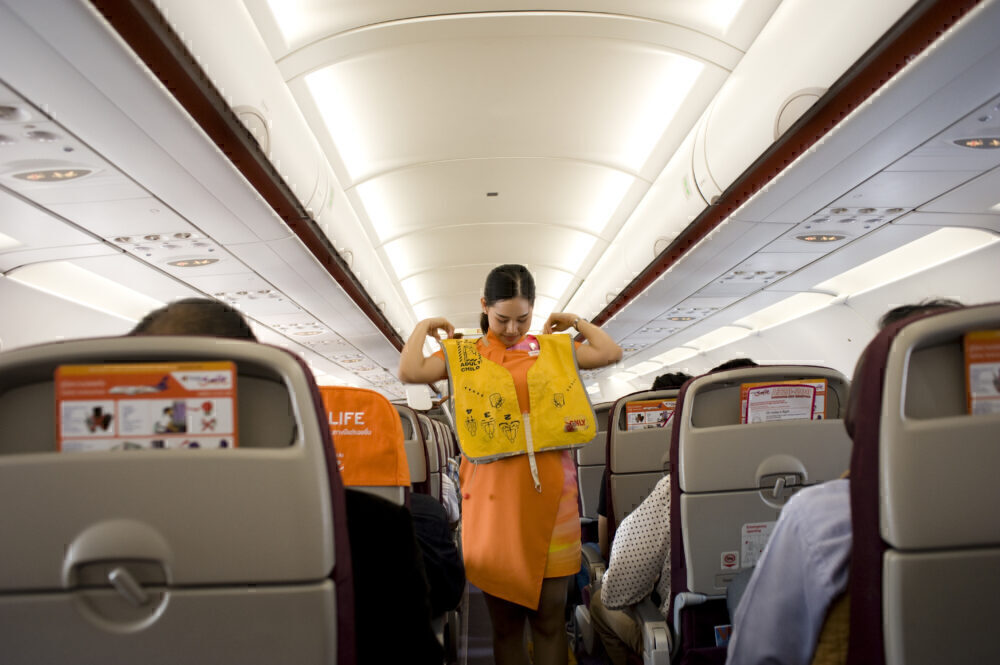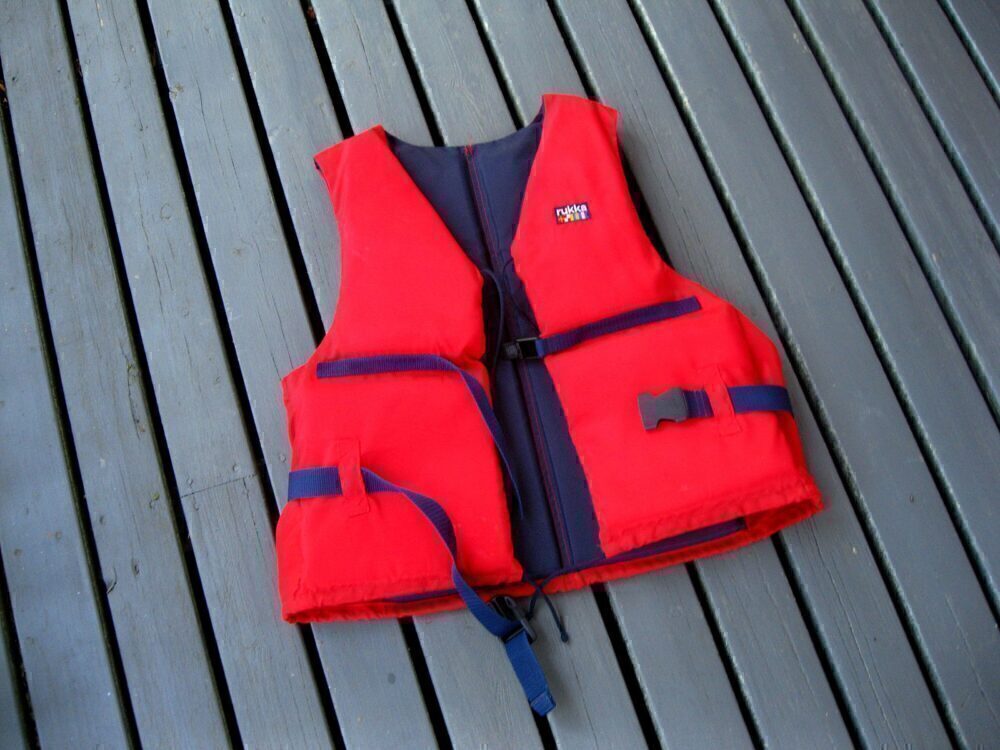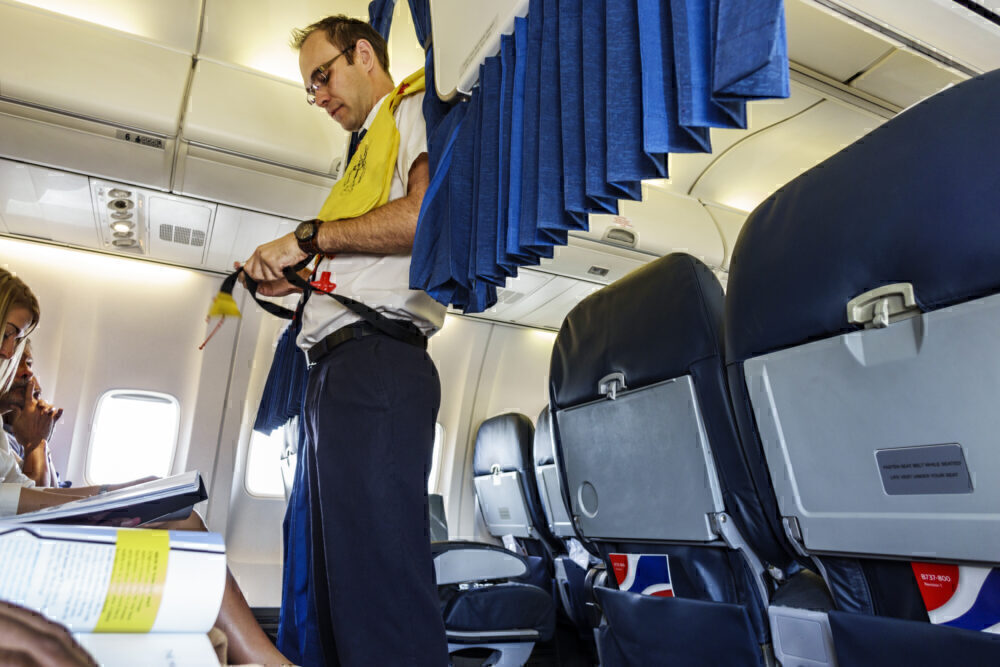Under normal circumstances, they are a very small part of an air traveler’s journey. So small, in fact, that they can fit snugly under the seat or inside an armrest. So how does this small, flat, brightly colored package turn into a flotation device that can carry a grown individual for at least twelve hours in the water?

In the unlikely event
If you are sincere, how much attention have you really paid during cabin crew security demonstrations on your past few flights? If you are reading this, you probably belong to the part of the traveling public who has got the buckling of the safety belt down pat. Should oxygen masks fall from the panel above your head, it would most likely be an automatic reflex for you to secure your own mask before assisting others.
While you may be aware that there is a life jacket beneath your seat, if nothing else because of the continuous reminder on the back of the seat in front of you, you may not have given further consideration to how they actually work. How do they go from flat little parcels to puffed-up vests capable of supporting an adult in the – unlikely – event of ditching?

Obligatory on extended overwater flights
The Federal Aviation Administration (FAA) of the US requires all extended overwater flights to carry life preservers. An extended overwater flight is one that is more than 50 NM from the shore. Their necessity, and even efficiency, are subject to debate. Meanwhile, it is a form of psychological support for many, knowing that they exist under the seat or in the armrest when taking off across an ocean.
Inherently buoyant vs. inflatable
The life jackets, as the cabin crew informs you, are inflatable. This means that they differ from those hanging in a boating shed which are already filled with something that will keep you afloat. Today, so-called inherently buoyant life jackets are filled with plastic foams, such as polyethylene. However, historically, they have been made using cork, balsa wood, or a natural fibrous substance called kapok.

Carbon dioxide cartridges
As inherently buoyant life jackets would take up far too much space on-board an aircraft, different solutions are needed. The kind of life jacket found on aircraft, and other inflatable versions, have cartridges of carbon dioxide gas sewn into them.
When the cartridges are activated by pulling on a tag specifically installed for the purpose, they release the gas, and the vests inflate. The jackets have two separate compartments in case one of them were to malfunction. If you have ever watched a life jacket inflation demonstration video, you will know that the sound is quite intense, and the inflation instantaneous.
Back-up oral tubes and battery lights
The life jackets are also fitted with backup oral inflation tubes so that their wearer can top up the air supply, should it be needed. Vests must remain uninflated while still in the aircraft. This is because it may otherwise hinder exit through the emergency doors or cause the jacket to tear on the way out, rendering it useless.
However, it is also due to that an aircraft could potentially turn over or flood. Should the life jacket already be inflated, this would cause its wearer to become trapped inside.
Aircraft life jackets are also equipped with a closed-circuit battery-driven light that automatically turns on contact with water. This is so that the wearer can be located during dark hours.

Waist-strap key to proper function
When the vest is pulled over the head, it does not matter which side is front or back. However, an important part is that the waist-strap needs to be fitted properly. Otherwise, the vest will float up around the face. Thus it will not offer sufficient flotation support and quite possibly constrict the field of vision.
Rigorous testing
When the vests are manufactured, a percentage of every batch will be put through a series of pressure assurance tests. This includes bursting them at two times the value of what it will experience with regular inflation.
The material from which life jackets are made is also tested through heat resistance and tear and breaking strength. Each vest is also inflated from an air supply for at least 12 hours before they are deflated again and the actual carbon dioxide cartridges are fitted.

How much do they really help?
As much as their function is put to the wire during manufacturing, however, it is unclear how beneficial they actually are in case of an emergency. Following the spectacular ditching of US Airways Flight 1549 on the Hudson River in New York, only 33 out of 150 passengers had a life vest. Out of the 33, only four people managed to secure their life-jackets properly, the Wall Street Journal reports.

Good for ten years
The life span of an inflatable jacket is limited to ten years. Once they expire, some enthusiasts manage to get their hands on them (much better than grabbing one from a plane as a souvenir, as has also been known to happen) and sometimes inflate them as a party trick or out of mere curiosity. Meanwhile, they could also be repurposed in more sustainable ways, such as the range of bags recently launched by THAI Airways.
Do you think you would have the peace of mind to locate, properly fit, and not prematurely inflate your life jacket if the pilot announced the aircraft would ditch on water? Leave a comment below and let us know.
[ad_2]
Source link


